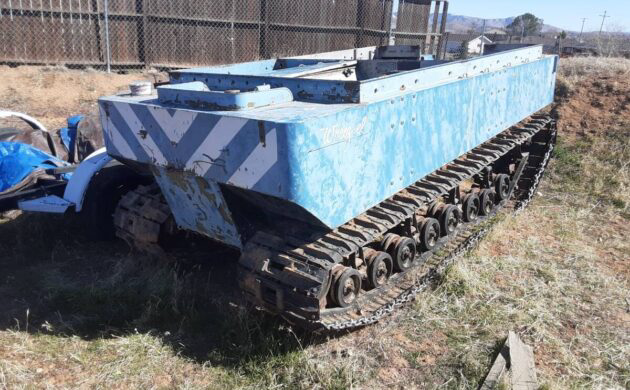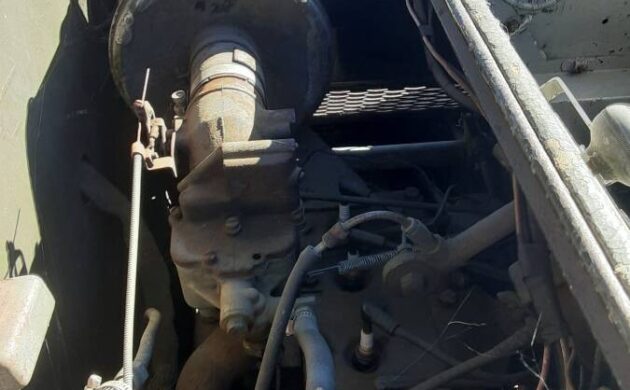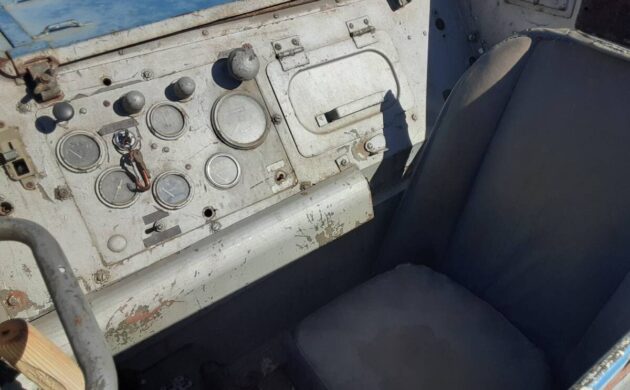Crawl Anywhere: 1943 Studebaker Weasel
Ingenuity during the war years resulted in myriad interesting vehicles, with an emphasis on mobility when faced with extreme terrain. These vehicles took a licking and kept on ticking – dropping into enemy territory off a helicopter sling, enduring snow, ice, sand, water, and mud, carrying everything from weapons to troops. Here on craigslist is a 1943 Studebaker T24 Weasel for sale, with an asking price of $11,000. This vehicle will need to be trailered from its home in Tehachapi, California. It has no title – only a bill of sale. It’s an early model, and it runs and drives but needs restoration. Thanks to T.J. once again for the … weird tip!
The Weasel was originally developed in 1942 to enable maneuvers in the snow. It crawled on metal tracks supported by boogie wheels, with motivation provided by Studebaker’s 170 cu. in. flathead six-cylinder Champion motor paired with a three-speed manual transmission and a two-speed transfer case. These motors were plentiful at the time, with the war having interrupted Champion production. The Weasel’s theoretical top speed was somewhere around 35 mph, and after some improvements, it was able to climb a sixty-degree hill. It exerted low ground pressure thanks to its wide tracks and could avoid damage by land mines. Weasels were considered so valuable that they came with pockets to store TNT so the vehicle could be destroyed in lieu of falling intact into enemy hands. As it turned out, the Weasel didn’t spend much time in the snow, but it proved crucial in several battles.
The Weasel didn’t have a steering wheel; instead, it utilizes control sticks for direction and braking. This photo shows the dash, where all the gauges and switches appear to be present. Weird as this vehicle is, over 15,000 were made, and research surfaced restoration help as well as parts. I even found an expired listing for a new old stock Weasel transmission. And here is the ultimate “Weasel Pick” showing the rescue of not one, not two, but SIX Weasels.
This Weasel needs some rust repair, a mechanical check-up, and perhaps a more appropriate paint job. Then the question is, what do you do with it? This fellow is restoring his Weasel to use on his nearly inaccessible property in Alaska. Or, you could take it to Home Depot for those fence boards you need, or park it in your driveway to annoy your HOA board. What do you think – got a need for a Weasel?
Auctions Ending Soon
 2002 Subaru Impreza WRXBid Now1 days$333
2002 Subaru Impreza WRXBid Now1 days$333
 1975 Chevrolet Corvette ConvertibleBid Now1 days$4,000
1975 Chevrolet Corvette ConvertibleBid Now1 days$4,000
 1964 Ford F-100 Camper CustomBid Now1 days$2,000
1964 Ford F-100 Camper CustomBid Now1 days$2,000
 2006 Jeep Wrangler SportBid Now3 days$11,000
2006 Jeep Wrangler SportBid Now3 days$11,000
 1974 Datsun 260ZBid Now5 days$750
1974 Datsun 260ZBid Now5 days$750





Comments
Very interesting find! Smaller than I thought when I first looked. If it comes with the TNT I am all in.
I’d like to have this, but a divorce at this point in my life would be a financial hardship from which I would probably never recover, so I’ll pass!
I never recovered and I turned out okay,,( cough),,,
Just think how many KIAs that would build. At almost 2 tons dry, crawl you will, the M29( T24) was never meant for speed, but we must remember, Dubja, Dubja 2, der, was all about mobility. Things change fast in war, and the country that can move the troops quickly, had a definite advantage. Today we blast them from a control center in Phoenix,,,anyway, Studebaker, and others, stepped up to the challenge,,,,and WE WON!!!,,Ahem, I mean, Studebaker never was a contender in the real world of cars, but their war efforts, I think, carried them through the 50’s.
I think this could still be used on a limited basis, but you still have to schlep this around, and that’s no fun today. Cool find, and a salute to this old soldier. Who knows how many lives these saved.
Studebaker was certainly a contender in wartime.
Studebaker produced about 250,000 2.5 ton trucks for “LendLease” export to the USSR…
Friend of mine just picked up one that had a spare set of tracks, and engine for 2K at an auction up here in Alaska. runs good enough that he’s going to use it to go Moose hunting this Fall. The cab is even on it and it’s insulated!
That is an early production T-24 model. You can tell by the bolts on the side that were to mount brackets to allow them to be loaded in a British Lancaster bomber bomb bay. They were to be parachuted into Norway with commandos on a suicide one-way mission to blow the Nazi Heavy Water plant there. The planners failed to include the RAF in their plans and Bomber Harris of the RAF nixed the plan to divert his bombers on such a scheme.
I don’t think the very few helicopters in WWII would have been able to carry this. But perhaps I am mistaken?
No, not at all.
And helos did not see combat service until late in the Pacific campaign. First use was a rescue operation in Indochina.
You are probably right. I think they were dropped from cargo planes.
The Weasel is somewhat rare in the US the vast majority of them went to Norway and other areas in that region. They were also built in an amphibious versione the tracks provided movement in the water with air tanks as flotation devices mounted on the sides of the body. For a very long time the elephant in the closet was the tracks extremely hard to find and build. About 10 years ago a company started to build very good replacement tracks, although not cheap they work very well. All in all the weasel is a pretty darned solid machine, easy to work on and very fun to drive in the snow. I have driven a couple different ones that had been restored they are a neat machine, the biggest issue with them is rust! One in this condition would expect to sell for around 9k.
While the Weasel was indeed hurried into production specifically with operations against Nazi Germany’s heavy water production facility in Telemark, Norway in mind, the operation was called off before the Weasel could get there. However the Norwegian army bought/received surplus Weasels after WW2 which saw varied use and last used as a recoillless rifle weapons carrier well into the 70s.
The Norwegian wiki site shows a nicely converted shuttle in civilian use for a mountain resort
https://no.wikipedia.org/wiki/M29_Weasel#/media/Fil:Weasel_Dovre.jpg
Very cool, i will search YouTube to see one running. It says the color is green?
Yes many on YouTube running.
Very cool, i will search YouTube to find one running. It says the color is green?
After finding three stripped spark plug holes on my 50 Champ Starlight Coupe, I found out how expensive heads were from Newman and Altman… I then found a Weasel specialist, who sold me two milsurp heads still in the packaging and cosmoline, for $14 each, cheaper than having Helicoil inserts installed
10 years later, when I sold it, the second head went into the trunk.
Weasels are very collectible. A number of MVPA members have restored, and shown them at meets.
The Canadian military also had Weasels, deploying them during WW2 in Europe, the Aleutian Islands, and into the 50s in the far north.
There was also an amphibious version, often called a “Swim Weasel” with floatation cells mounted front and rear. I have been in open water in a Swim Weasel, and it performed surprisingly well in light chop, although not fast.
The Weasel for sale here needs major metal work in addition to general restoration. It appears to have been extensively modified with the “walk-through” cut into the rear.
makes me want to buy a farm, just so I can get one to run around on it ….looks like too much fun
I believe the Weasle was used heavily by the Canadian Army in the Battle of the Scheldt Estuary. Antwerp could not be used as a port unless the Scheldt was controlled. This meant Walchern Island had to be reduced. The Germans opened the dykes and we were confronted with a dug in enemy battling for control of the tops of dykes covered by machine guns and mortars. Add to all this, the battle was fought in miserable winter weather.
But for the Weasle we would have lost even more men.